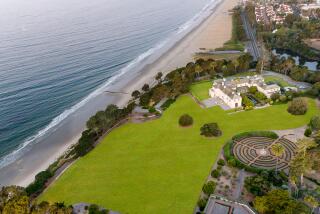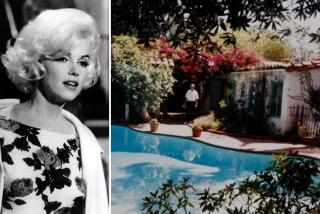Britain’s Ancestral Manors Threatened as Bluebloods Hit Hard Times : History: Scions of aristocratic families find castle upkeep costly. Some open their homes to the public in return for tax breaks; others simply put them on the auction block.
- Share via
ELTON, England — William Proby’s roof needs fixing, and that’s a $1.5-million problem.
Last spring, mounting costs forced Princess Alice, the queen’s aunt, to lay off the butler and leave the family’s 427-year-old country house, Barnwell Manor.
And now poor Lord Lovat has had to sell his family’s beloved Beaufort Castle, along with the estates, the silver, the ancestral portraits and the antique furniture.
For Britain’s aristocracy, it’s a never-ending struggle between keeping up their stately homes or throwing in the towel to the hoteliers, the golf course developers, the self-made millionaires, the oil sheiks.
The burdens of scions of families who enjoyed centuries of wealth and privilege are a hard sell politically.
But, like single parents and state pensioners, stately home owners feel put upon after 16 years of Conservative Party government.
“We’re not asking for something for nothing,” said Proby, chairman of the Historic Houses Assn., which seeks better tax breaks. “What we’re saying is, if we look after these houses and we open them to the public, then we want something in return.”
To qualify for government help, which includes 50% grants for major repairs, owners must open stately homes to the public for a few days a week.
In 1980, Proby inherited Elton Hall, a 100-room medieval, turreted pile outside this village 70 miles north of London. His family has lived in the house, which dates to 1475, since 1660.
For the last two decades, stately homes have been going under the auction hammer at the rate of 25 a year. Their furnishings, outlying parks and valuable farmland are often broken up and sold separately.
About 1,450 estates are still occupied by families that have owned them for at least three generations.
Famous historic houses are safe, such as the Duke of Marlborough’s magnificent Blenheim Palace near Oxford, or Woburn Abbey, which the 13th Duke of Bedford, driven by post-World War II taxes, turned into a wildlife park in the 1950s.
It’s the next rank of houses, the middle-size huge ones, that Proby says may “slip away” over the next 20 years.
Basic upkeep runs around $200,000 a year.
Then there are the embarrassing shuttles of a painting, an ancient tapestry or a chunk of family silver to the auction houses to cover the big expenses.
Some owners just sit it out--leaving their heirs a legacy of crumbling masonry, drafty rooms and taxes.
The Lovats, beset by deaths and business failures, were $11 million in debt when 18-year-old Simon Fraser succeeded his grandfather in March as the 18th Lord Lovat and 25th Chief of the Clan Fraser.
Beaufort Castle’s new owner, Ann Gloag, a Scottish bus millionaire, paid nearly $4 million cash for the castle in the Highlands, its contents and a farm.
Some owners look to tourists to help foot the bill. Prearranged tours of Americans and other foreign groups are sought after.
There is also farming income. But keeping the ancestral roof over their heads often forces bluebloods to turn to sordid commerce.
Sir Thomas Ingilby lives on the second floor of Ripley Castle in Yorkshire, the family seat for 650 years. The rest is a hotel and convention center. Now he has licensed a castle room for weddings.
“What you really miss is the big loss of privacy,” Ingilby said. “We’ve got a private garden, but . . . you can still get a coach party [busload] of 53 people right alongside you looking over the hedge.”
Others just give up.
“It was like putting three or four grand a week into a bucket and dropping it down a well, and all because of the aristocracy’s obsession with keeping their estates going for the next generation,” said the Marquess of Milford Haven. “It virtually ruined me.”
His brother, Lord Ivar Mountbatten, is now trying to make the family estate, Moyns Park, pay.
Princess Alice’s son, the Duke of Gloucester, couldn’t afford the family manor house, despite a $270,000 annual handout from his cousin, Queen Elizabeth II.
Earl Spencer, 31, Princess Diana’s brother, found their family seat, Althorp, running at a $700,000 yearly loss when he inherited in 1992. He blamed mismanagement by his stepmother.
At Elton Hall, Proby argues that the cause of the stately home owners encompasses Britain’s history, culture and heritage, not to mention the 11.2 million tourists who visit each year.
When new money buys in, the houses often reappear on the market within a few years, looking more like white elephants without their contents. And the nouveau riche who do stay on don’t allow public access.
“People come to this country not for the weather; they come for the built heritage,” said Proby.
More to Read
Sign up for Essential California
The most important California stories and recommendations in your inbox every morning.
You may occasionally receive promotional content from the Los Angeles Times.













